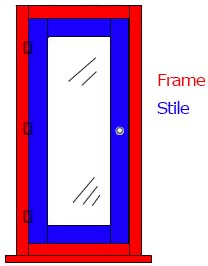Panic Device Basics
Panic Devices and Exit Devices are essentially the same thing; they both are spring loaded metal bars that unlatch
the door when depressed. Panic Devices must provide a path of emergency egress.
Panic Devices are a standard in commercial doors because of their ease of operation
and the safety features they offer. They eliminate a stampede crushing hazard and cut the time needed to unlock a door in an
emergency situation because even someone with no prior knowledge of how to open the door can do so simply by pressing it.
Types Of Panic Devices:
- Rim Type Panic Device:
Rim Exit Devices are surfaced mounted to the door's exterior where the latch protrudes from the device rather than the edge of the door.
For Rim Panic Devices, the strike plate is mounted on the door frame, a mullion for double
doors, or the inactive door for double doors without a center mullion.
- Vertical Rod Type Panic Device:
Vertical Rod Exit Devices (Latch control Rods are mounted Vertical on door) can be either surface mounted or concealed.
- Mortise Panic Device: A Mortise Exit Device has its locking mechanism mortised into a cavity in the door, so that the strike projects from the door's edge.
Just like a Rim Panic Device, the strike plate is mounted on the door frame, a mullion for double doors, or the inactive door for double doors with no mullion.
Bar Types:
|
Crash Bar Exit Devices are typically used on glass doors because they have a smaller silhouette.
Crossbar Exit Devices are operated by depressing anywhere on the bar, unlike a
push bar style panic device where the touch pad must be pressed.
This type of panic hardware is also used in heavy traffic areas for this feature
because it only requires
someone crashing into it to retract the latch and open the door.
|

|
Once you know what type of panic device you'll need, it's time to gather information about your door so you can choose the right one.

|
- Door Width:
- Panic Devices are made to fit doors within a specific door with range. Many models are
field sizable (cut to fit) for doors between certain widths.
- Door Height
- Vertical Rod Exit Devices are measured to fit specified door heights.
- Lock Stile Width:
- The Lock Stile is the part of the door onto which an exit device or other lock is installed.
- When a door has a stile less than 2", it is known as a Narrow Stile.
- Door Thickness
- Door thickness may matter, especially if you are looking for exterior trim.
- Exterior Trim is what is on the outside of the door.
- Fire Rating
- If you wish to install a Exit Device on a Fire Door,
then you need a model that cannot be dogged.
- Dogging or dogging down is when the bar is locked either by a key or a hex key into
the depressed position so that the door swings freely without latching.
Many commercial buildings do this during business hours, especially on doors that have heavy traffic.
However, fire doors must always remain in the closed and latched position to keep the flames and smoke from advancing so
Fire Rated Commercial Exit Devices cannot be dogged down.

|
How To Field Size a Panic Device:
Push Bar Type Exit Devices:
Remove the end cap and cut from Section A of the push bar to meet your door's width.
Crash Bar Type Exit Devices:
Simply cut the bar to the desired length and then install it in the lever arms.
Rim Panic Device Guide -
Next Page
|












